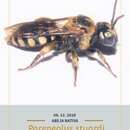fi
nimet breadcrumb-navigoinnissa


The Osirini are a tribe of cuckoo bees in the family Apidae, all but one genus exclusively from the Neotropics, and laying their eggs in the nests of bees in the apid tribe Tapinotaspidini; the one exceptional genus is Epeoloides, which has one North American species and one European species, both of which attack the melittid genus Macropis.
All species in this tribe are unique among the bees in the possession of a tiny sclerite embedded in the membrane beneath the head, possibly to help guard against being stung in the neck by an angry host bee when invading a nest.
The Osirini are a tribe of cuckoo bees in the family Apidae, all but one genus exclusively from the Neotropics, and laying their eggs in the nests of bees in the apid tribe Tapinotaspidini; the one exceptional genus is Epeoloides, which has one North American species and one European species, both of which attack the melittid genus Macropis.
All species in this tribe are unique among the bees in the possession of a tiny sclerite embedded in the membrane beneath the head, possibly to help guard against being stung in the neck by an angry host bee when invading a nest.
Les Osirini sont une tribu d'insectes hyménoptères de la famille des Apidae (une des familles d'abeilles).
Les espèces de cette tribu se rencontrent en Amérique et en Europe.
Ce sont des abeilles cleptoparasites.
Selon ITIS (25 avr. 2010)[1] :
Les Osirini sont une tribu d'insectes hyménoptères de la famille des Apidae (une des familles d'abeilles).
Gli Osirini Handlirsch, 1925 sono una tribù di imenotteri apoidei cleptoparassiti della famiglia Apidae.
Il tratto caratteristico di questa tribù è la presenza di un piccolo sclerite incorporato nella membrana cervicale.[1]
Le femmine sono prive delle tipiche strutture per la raccolta del polline degli apoidei.
Hanno un comportamento cleptoparassita, cioè depongono le uova nei nidi di altre specie, facendo sviluppare le proprie larve a spese delle riserve dell'ospite. La gran parte degli Osirini parassitano i nidi di specie della tribù Tapinotaspidini (Apidae), con l'eccezione del genere Epeoloides, che depone le uova nei nidi di Macropis spp. (Melittidae).[2]
La tribù è distribuita quasi esclusivamente nell'ecozona neartica e neotropicale, con l'eccezione del genere Epeoloides, che è presente con 1 specie in Nord America e 1 specie in Europa.[1]
La tribù Osirini comprende i seguenti generi:[3]
Gli Osirini Handlirsch, 1925 sono una tribù di imenotteri apoidei cleptoparassiti della famiglia Apidae.
Osirini Handslirsch, 1925[1]
Osirini (лат.) — триба пчёл из подсемейства Apinae семейства Apidae.
Неотропика, Неарктика, Палеарктика.[2]
Клептопаразитическая группа, большинство представители которой откладывают свои яйца в гнёзда пчёл трибы Tapinotaspidini. Представители Голарктического рода Epeoloides атакуют пчёл рода Macropis. Все виды этой трибы уникальны среди пчёл благодаря наличию небольшого склерита в задней нижней части головы, который, возможно, помогает как воротник защищать уязвимую шею от ужалений пчелы хозяина при вторжении в её гнездо.[3]
Известно 5 родов.[4]